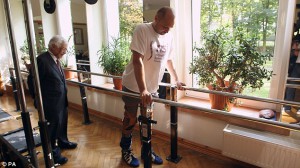 Breakthrough spinal injury surgery in Europe has given a paralysed man the chance to walk again. The pioneering technique involved transplanting olfactory ensheathing cells (OECs) from the man’s nasal cavity into his spinal cord which had been cut due to a knife injury.
Breakthrough spinal injury surgery in Europe has given a paralysed man the chance to walk again. The pioneering technique involved transplanting olfactory ensheathing cells (OECs) from the man’s nasal cavity into his spinal cord which had been cut due to a knife injury.
According to Sydney spinal cord surgeon, Dr Timothy Steel, this is the first case he is aware of using stem cells to regenerate a spinal cord defect. Dr Steel told F2L that use of the olfactory bulb stem cells is the best type of stem cells as these are the only stem cells, of neurological origin, that are available to repair the spinal nerves. “The methodology behind this treatment is very impressive,” he said. However, given the nature of the injury Dr Steel believed there would be a limited number of patients who would benefit from this therapy as having such a clean cut was negligibly rare. “I have only seen one spinal cord injury due to a knife in 25 years. It is very unusual to cleanly sever the spinal cord.”
In spite of these reservations, Dr Steel described the treatment as the most realistic advance in spinal cord surgery he had read. “The methodology sounds good, as long as it is a genuine case of the cord being transected, with no prior function. It is always difficult to know in a case like this with a partial spinal cord injury if the patient was going to recover some function over time anyway. This spinal cord was sectioned in half. If, in this case if the spinal cord was sectioned, the nerves should not have grown across as originally there would not have been the opportunity to get neurological recovery. If they have achieved neurological recovery return of neurological function it is a tremendous advance.”
As to the surgery being performed in Australia, Dr Steel was circumspect. “Enrolling patients of this type would be difficult and is a long way off from being freely available. We would want to see more cases, learn the technique. But certainly given the logistics of it and the idea of harvesting olfactory bulb stem cells and growing these cells it is a fantastic development,” he said.
Two years after the surgery, the 38-year old patient is now walking using a frame and has recovered some sensation in his lower body. The treatment, which is a world first, was performed by Polish surgeons in collaboration with UK research team.
Information about the surgery will be made available to researchers around the world.
